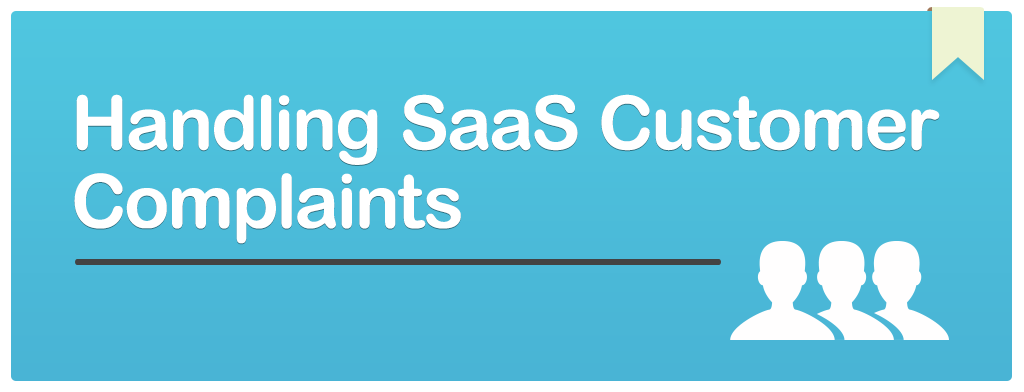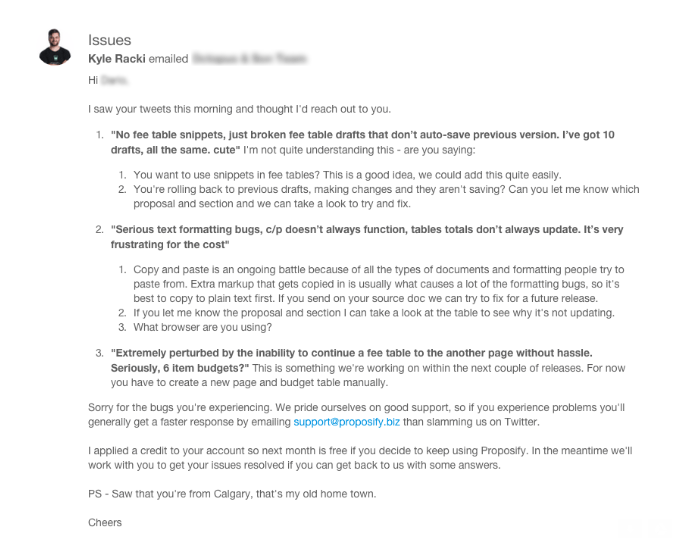
We’d all like business to just be smooth-sailing as much as possible, but in reality, every business goes through rough patches, including having to deal with customer complaints.
For SaaS concerned about churn, complaints are something you need to get a good handle over, yet many SaaS do not seem to deal with complaints well. It’s easy to see why in some early startups; resources are stretched and often there are just one or two of you trying to keep up.
Complaints aren’t always a bad thing—sometimes they provide you with the feedback you needed to make an improvement. Sometimes they come from customers who actually want to remain customers, but other times they might come because the customer was the wrong fit in the first place.
The last thing you need is for complaints to escalate and become poor reviews or roastings on social media, so here are a few things to consider if your SaaS needs to handle some customer complaints:
Develop a Process
As this CMS Wire article discusses, your SaaS is not just about having an amazing product. Customers are looking for a great overall experience too, which means having your service up to a high standard.
We’ve written a bit about service previously; even if your team has the best customer-facing aptitude in the world, they need guidelines based on the best-practices of world-class customer-centric companies. (Even if your “team” currently consists of two founders).
It makes total sense to develop customer service policies, including how to handle complaints early on. If you’ve grown to the point where you have a larger team, you are probably that much more busy and less inclined to spend the time on documenting the process.
The idea behind documenting is consistency. You want your customers to feel that they get a consistent experience every time they make contact with you. That means if they call today and speak with Jane about a certain issue, they shouldn’t get a different response if they speak to Bob about the same thing tomorrow.
Besides the customer experience, documenting your processes makes life easier for you in the long-run. What if you wanted to use an external helpdesk such as Zendesk or HelpScout while you’re not quite big enough to hire an internal team? You will need those processes developed so that an external desk can do their job properly and your customers don’t notice the difference.
Service Recovery Paradox
Groove wrote about a process for dealing with angry customers a couple of years ago:

The idea is that how you handle the complaint can either turn the customer away or cause them to be quite loyal to your business because you impressed them with how you dealt with the issue.
Here is a suggested procedure for turning the complaint around, based on The Walt Disney Company policies:
- Hear – Allow the customer to say their piece without interruption.
- Empathize – Show you understand why they’re upset.
- Apologize – A sincere apology can go a long way!
- Resolve – Do what is needed to resolve the complaint quickly, including empowering staff to make a decision. “How can we make this right?” is a great question!
- Diagnose – Get to the bottom of why the complaint situation occurred. Do you need to make changes to your processes?
Be Prompt
We know you’re busy, but often the way to really impress a customer, plus prevent a rapid escalation of the issue is to prioritize responding to complaints. We live in a time where communication is almost instantaneous and expectations of a response tend to be magnified, especially with the instant environment of social media.
When a customer complains, they are often bracing themselves for a negative response from you. It can be a pleasant surprise when you respond promptly and professionally.
Be Transparent
Transparency is always important, whether it’s in handling complaints or preventing them from happening in the first place. It’s about generating trust with the customer. As Kissmetrics points out, many customers are still highly skeptical of SaaS:
“The average customer sees a piece of software that costs a lot, but doesn’t seem to require a whole lot of overhead on the part of the provider. Sure, there’s some development and marketing cost, but where is all the customer’s hard-earned money going? The skeptical customer raises an eyebrow, too, over any possible security breaches and opaque contract language.”
CMS Wire wrote about a transparent model of customer service for SaaS, which includes having clear policies around service availability and customer support. It makes sense: many SaaS are fulfilling a function which replaces the business needing to hire someone.
More from Kissmetrics on maintaining transparency:
“Transparency is the only way to overcome the skepticism and to build back trust. Here are some of the specific ways you can create an attitude of transparency:
- Notify users of downtime.
- Give customer advance notice of pricing or contract changes.
- Explain to customers where their money goes.
- Answer any questions that prospective customers have.
- Make it easy for customers to cancel service.”
If you do these things, you’re automatically eliminating a bunch of reasons why a customer might complain in the first place.

Source: Groove
Measure
Part of handling customer complaints is being aware of any possible issues in the first place. Salesforce recommends that SaaS regularly measure satisfaction with surveys or by contacting them directly.
You should also keep a good handle over data such as whether there are recognizable common complaints, whether perhaps customers are complaining because they weren’t a good fit for your product in the first place, or even if it’s the same customers for whom you’re always dealing with a complaint.
Some people will say to “fire” those customers who are chronic complainers, but Jason Lempkin has a different view, pointing out that the ones who actually churn are not usually the ones to complain—they often leave silently. Could they still be a valuable source of MRR? Maybe, depending on your view of the resources they require.
Complaint data also gives you a chance to notice whether there are any issues with your marketing or onboarding. Are you attracting customers who aren’t a good fit because something needs adjusting in how you present your SaaS?
Final Thoughts
Handling customer complaints in your SaaS may be something you haven’t given much thought to yet if you’re relatively new, but it pays to develop a clear policy early on if you want to create a good customer experience.
Whether you are a two-person team or twenty, you want to ensure that your customers have a consistent (preferably excellent!) experience with your business. You can have the most amazing software out, but part of the whole SaaS deal for customers is the experience they have.
Document your policies, respond promptly and be transparent with your customers. Be proactive about providing a level of service that helps to eliminate complaints in the first place.
Lastly, keep measuring and acting upon complaint or customer satisfaction data. The complaints you receive can be an opportunity to get good feedback and take remedial action.

